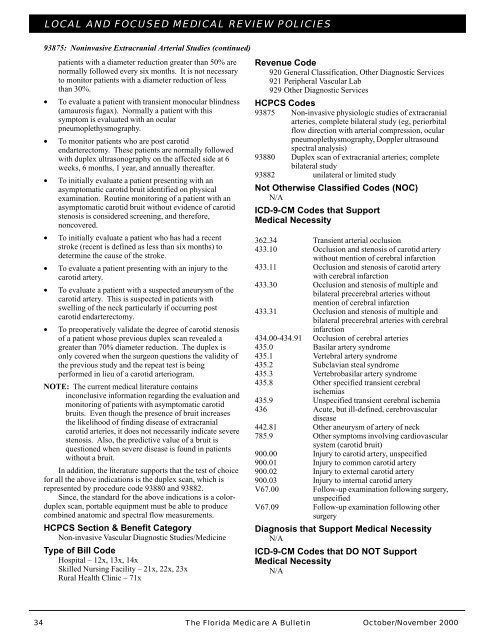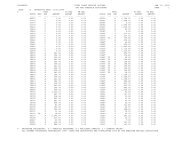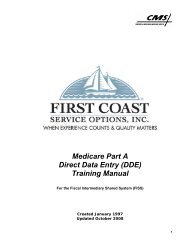Oct-Nov 00 Part A Bulletin - Medicare
Oct-Nov 00 Part A Bulletin - Medicare
Oct-Nov 00 Part A Bulletin - Medicare
Create successful ePaper yourself
Turn your PDF publications into a flip-book with our unique Google optimized e-Paper software.
LOCAL AND FOCUSED MEDICAL REVIEW POLICIES<br />
93875: Noninvasive Extracranial Arterial Studies (continued)<br />
patients with a diameter reduction greater than 50% are<br />
normally followed every six months. It is not necessary<br />
to monitor patients with a diameter reduction of less<br />
than 30%.<br />
• To evaluate a patient with transient monocular blindness<br />
(amaurosis fugax). Normally a patient with this<br />
symptom is evaluated with an ocular<br />
pneumoplethysmography.<br />
• To monitor patients who are post carotid<br />
endarterectomy. These patients are normally followed<br />
with duplex ultrasonography on the affected side at 6<br />
weeks, 6 months, 1 year, and annually thereafter.<br />
• To initially evaluate a patient presenting with an<br />
asymptomatic carotid bruit identified on physical<br />
examination. Routine monitoring of a patient with an<br />
asymptomatic carotid bruit without evidence of carotid<br />
stenosis is considered screening, and therefore,<br />
noncovered.<br />
• To initially evaluate a patient who has had a recent<br />
stroke (recent is defined as less than six months) to<br />
determine the cause of the stroke.<br />
• To evaluate a patient presenting with an injury to the<br />
carotid artery.<br />
• To evaluate a patient with a suspected aneurysm of the<br />
carotid artery. This is suspected in patients with<br />
swelling of the neck particularly if occurring post<br />
carotid endarterectomy.<br />
• To preoperatively validate the degree of carotid stenosis<br />
of a patient whose previous duplex scan revealed a<br />
greater than 70% diameter reduction. The duplex is<br />
only covered when the surgeon questions the validity of<br />
the previous study and the repeat test is being<br />
performed in lieu of a carotid arteriogram.<br />
NOTE: The current medical literature contains<br />
inconclusive information regarding the evaluation and<br />
monitoring of patients with asymptomatic carotid<br />
bruits. Even though the presence of bruit increases<br />
the likelihood of finding disease of extracranial<br />
carotid arteries, it does not necessarily indicate severe<br />
stenosis. Also, the predictive value of a bruit is<br />
questioned when severe disease is found in patients<br />
without a bruit.<br />
In addition, the literature supports that the test of choice<br />
for all the above indications is the duplex scan, which is<br />
represented by procedure code 93880 and 93882.<br />
Since, the standard for the above indications is a colorduplex<br />
scan, portable equipment must be able to produce<br />
combined anatomic and spectral flow measurements.<br />
HCPCS Section & Benefit Category<br />
Non-invasive Vascular Diagnostic Studies/Medicine<br />
Type of Bill Code<br />
Hospital – 12x, 13x, 14x<br />
Skilled Nursing Facility – 21x, 22x, 23x<br />
Rural Health Clinic – 71x<br />
Revenue Code<br />
920 General Classification, Other Diagnostic Services<br />
921 Peripheral Vascular Lab<br />
929 Other Diagnostic Services<br />
HCPCS Codes<br />
93875 Non-invasive physiologic studies of extracranial<br />
arteries, complete bilateral study (eg, periorbital<br />
flow direction with arterial compression, ocular<br />
pneumoplethysmography, Doppler ultrasound<br />
spectral analysis)<br />
93880 Duplex scan of extracranial arteries; complete<br />
bilateral study<br />
93882 unilateral or limited study<br />
Not Otherwise Classified Codes (NOC)<br />
N/A<br />
ICD-9-CM Codes that Support<br />
Medical Necessity<br />
362.34 Transient arterial occlusion<br />
433.10 Occlusion and stenosis of carotid artery<br />
without mention of cerebral infarction<br />
433.11 Occlusion and stenosis of carotid artery<br />
with cerebral infarction<br />
433.30 Occlusion and stenosis of multiple and<br />
bilateral precerebral arteries without<br />
mention of cerebral infarction<br />
433.31 Occlusion and stenosis of multiple and<br />
bilateral precerebral arteries with cerebral<br />
infarction<br />
434.<strong>00</strong>-434.91 Occlusion of cerebral arteries<br />
435.0 Basilar artery syndrome<br />
435.1 Vertebral artery syndrome<br />
435.2 Subclavian steal syndrome<br />
435.3 Vertebrobasilar artery syndrome<br />
435.8 Other specified transient cerebral<br />
ischemias<br />
435.9 Unspecified transient cerebral ischemia<br />
436 Acute, but ill-defined, cerebrovascular<br />
disease<br />
442.81 Other aneurysm of artery of neck<br />
785.9 Other symptoms involving cardiovascular<br />
system (carotid bruit)<br />
9<strong>00</strong>.<strong>00</strong> Injury to carotid artery, unspecified<br />
9<strong>00</strong>.01 Injury to common carotid artery<br />
9<strong>00</strong>.02 Injury to external carotid artery<br />
9<strong>00</strong>.03 Injury to internal carotid artery<br />
V67.<strong>00</strong> Follow-up examination following surgery,<br />
unspecified<br />
V67.09 Follow-up examination following other<br />
surgery<br />
Diagnosis that Support Medical Necessity<br />
N/A<br />
ICD-9-CM Codes that DO NOT Support<br />
Medical Necessity<br />
N/A<br />
34 The Florida <strong>Medicare</strong> A <strong>Bulletin</strong><br />
<strong>Oct</strong>ober/<strong>Nov</strong>ember 2<strong>00</strong>0





